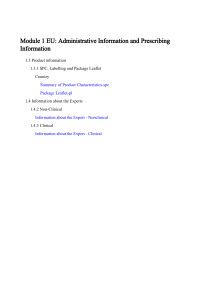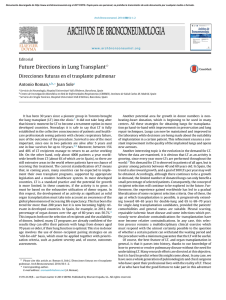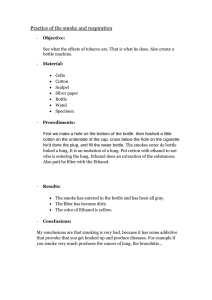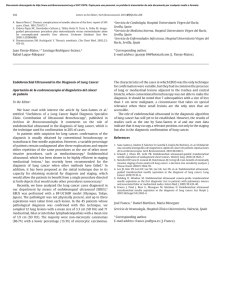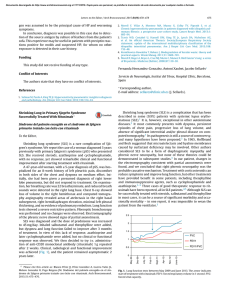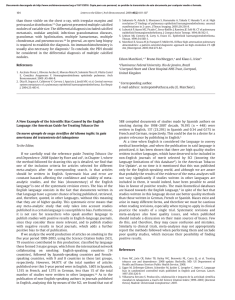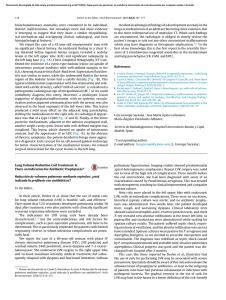PRRSV & Pneumocyte Proliferation in Pigs: A Pathology Study
Anuncio
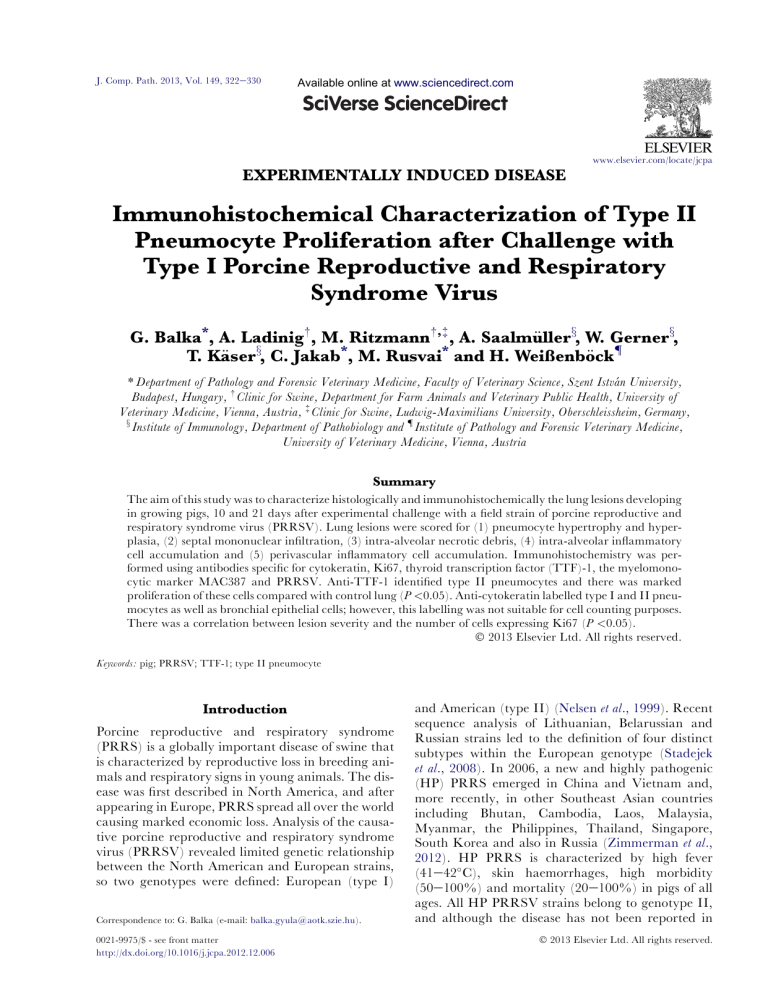
J. Comp. Path. 2013, Vol. 149, 322e330
Available online at www.sciencedirect.com
www.elsevier.com/locate/jcpa
EXPERIMENTALLY INDUCED DISEASE
Immunohistochemical Characterization of Type II
Pneumocyte Proliferation after Challenge with
Type I Porcine Reproductive and Respiratory
Syndrome Virus
G. Balka*, A. Ladinig†, M. Ritzmann†,‡, A. Saalm€
ullerx, W. Gernerx,
ock{
T. K€
aserx, C. Jakab*, M. Rusvai* and H. Weißenb€
* Department of Pathology and Forensic Veterinary Medicine, Faculty of Veterinary Science, Szent Istvan University,
Budapest, Hungary, † Clinic for Swine, Department for Farm Animals and Veterinary Public Health, University of
Veterinary Medicine, Vienna, Austria, ‡ Clinic for Swine, Ludwig-Maximilians University, Oberschleissheim, Germany,
x
Institute of Immunology, Department of Pathobiology and { Institute of Pathology and Forensic Veterinary Medicine,
University of Veterinary Medicine, Vienna, Austria
Summary
The aim of this study was to characterize histologically and immunohistochemically the lung lesions developing
in growing pigs, 10 and 21 days after experimental challenge with a field strain of porcine reproductive and
respiratory syndrome virus (PRRSV). Lung lesions were scored for (1) pneumocyte hypertrophy and hyperplasia, (2) septal mononuclear infiltration, (3) intra-alveolar necrotic debris, (4) intra-alveolar inflammatory
cell accumulation and (5) perivascular inflammatory cell accumulation. Immunohistochemistry was performed using antibodies specific for cytokeratin, Ki67, thyroid transcription factor (TTF)-1, the myelomonocytic marker MAC387 and PRRSV. Anti-TTF-1 identified type II pneumocytes and there was marked
proliferation of these cells compared with control lung (P <0.05). Anti-cytokeratin labelled type I and II pneumocytes as well as bronchial epithelial cells; however, this labelling was not suitable for cell counting purposes.
There was a correlation between lesion severity and the number of cells expressing Ki67 (P <0.05).
Ó 2013 Elsevier Ltd. All rights reserved.
Keywords: pig; PRRSV; TTF-1; type II pneumocyte
Introduction
Porcine reproductive and respiratory syndrome
(PRRS) is a globally important disease of swine that
is characterized by reproductive loss in breeding animals and respiratory signs in young animals. The disease was first described in North America, and after
appearing in Europe, PRRS spread all over the world
causing marked economic loss. Analysis of the causative porcine reproductive and respiratory syndrome
virus (PRRSV) revealed limited genetic relationship
between the North American and European strains,
so two genotypes were defined: European (type I)
Correspondence to: G. Balka (e-mail: [email protected]).
0021-9975/$ - see front matter
http://dx.doi.org/10.1016/j.jcpa.2012.12.006
and American (type II) (Nelsen et al., 1999). Recent
sequence analysis of Lithuanian, Belarussian and
Russian strains led to the definition of four distinct
subtypes within the European genotype (Stadejek
et al., 2008). In 2006, a new and highly pathogenic
(HP) PRRS emerged in China and Vietnam and,
more recently, in other Southeast Asian countries
including Bhutan, Cambodia, Laos, Malaysia,
Myanmar, the Philippines, Thailand, Singapore,
South Korea and also in Russia (Zimmerman et al.,
2012). HP PRRS is characterized by high fever
(41e42 C), skin haemorrhages, high morbidity
(50e100%) and mortality (20e100%) in pigs of all
ages. All HP PRRSV strains belong to genotype II,
and although the disease has not been reported in
Ó 2013 Elsevier Ltd. All rights reserved.
Pneumocyte Proliferation in PRRSV Infection
Europe, a type I subtype III strain (the ‘Lena’ strain)
causes high fever, anorexia, depression and 40% mortality in experimental infection (Karniychuk et al.,
2010).
PRRSV shows strong affinity for the lung and especially for its primary target cell, the alveolar macrophage. Both apoptotic and necrotic changes are
observed in these cells, markedly decreasing the immunological defence in the lung. Additionally, cytokines and chemokines released by virus-infected cells
contribute to damage to the lung parenchyma
(referred to as a ‘bystander effect’) (Kim et al., 2002;
Miller and Fox, 2004; Lee and Kleiboeker, 2007). Microscopically, the infection is reported to cause interstitial pneumonia characterized by hyperplastic and
hypertrophic type II pneumocytes, septal infiltration
by mononuclear cells and accumulation of necrotic
alveolar exudate (Halbur et al., 1996; Rossow, 1998;
G
omez-Laguna et al., 2010).
Type II pneumocytes are cuboidal cells, located
typically at the insertion of the alveolar septa. In
mammalian lungs, type II pneumocytes constitute
60% of all alveolar epithelial cells, but cover only
about 5% of the alveolar surface (Crapo et al.,
1982). Their most important role is the synthesis,
secretion and recycling of pulmonary surfactant,
which reduces alveolar surface tension, preventing
collapse during expiration. The other important function of the type II pneumocytes lies in their proliferative potential. After injury of type I pneumocytes,
type II pneumocytes serve as progenitor cells to replace and eventually differentiate into damaged and
desquamated type I pneumocytes. Their phagocytic
ability removes apoptotic type II pneumocytes and
immunoregulatory activity occurs via interactions
with macrophages and lymphocytes (Fehrenbach,
2000). Clara cells are non-ciliated, non-mucus-secreting progenitor cells that can proliferate and replace
ciliated and other non-ciliated cells in the terminal
part of the bronchi (Caswell and Williams, 2007).
Thyroid transcription factor (TTF)-1 is a 38 kDa
homeodomain-containing nuclear protein and
a member of the Nkx2 transcription factor family.
The protein was originally described as a regulator
of the thyroid-specific transcription of thyroglobulin,
thyroperoxidase and thyrotropin receptor. In the
lung, TTF-1 regulates surfactant gene and Clara
cell secretory protein gene transcription (Bohinski
et al., 1994; Ray et al., 1996; Zhou et al., 1996). As
TTF-1 is expressed in the nuclei of type II pneumocytes and Clara cells in the lungs, it is widely used
as a marker for the diagnosis of primary and metastatic lung cancer (Tan et al., 2003).
The aims of the present study were (1) to determine
whether humanized anti-TTF-1 antibodies cross-
323
react with porcine type II pneumocytes, (2) to determine whether PRRSV infection leads to proliferation
of type II pneumocytes, and (3) to characterize the
nature of the inflammatory lesions induced in the
lung by PRRSV infection.
Materials and Methods
Twenty-four 8-week-old piglets were obtained from
a conventional farm in lower Austria that was known
to be free of PRRSV. The piglets were vaccinated
against Mycoplasma hyopneumoniae and porcine circovirus type 2 at 3 weeks of age. Blood samples were taken
from the animals at the time of arrival at the experimental unit and tested for antibodies against PRRSV
by enzyme-linked immunosorbent assay (ELISA)
and by quantitative reverse transcriptase polymerase
chain reaction (RT-PCR) to confirm PRRSV negativity. After one week of acclimatization in an L3
safety level housing unit, 12 pigs were inoculated intranasally with 2.2 105 TCID50 of type 1, subtype
1 virulent German PRRSV field isolate. The open
reading frame (ORF)-5 nucleotide sequence of this
isolate is 90% identical to that of the Lelystad type
I reference strain (GenBank accession number
M96262), while the glycoprotein (GP)-5 amino acid
sequence is 92% identical to that strain. Negative
control pigs (n ¼ 12) were inoculated with virus-free
cell culture supernatant. Animals were killed at 10
(n ¼ 7) and 21 (n ¼ 5) days post infection (dpi).
During the course of the study, clinical signs, rectal
temperature and average daily weight gain were
monitored.
At necropsy examination, gross lung lesions (e.g.
tan mottled areas or areas of consolidation) were
scored by visual examination based on the percentage
of each lobe affected (Halbur et al., 1995). The percentage of lung lobe with lesions was used to calculate
the total weighted lung lesion score. The WilcoxoneManneWhitney test was used to investigate differences between the infected and control groups.
Separate analyses were performed for mottled areas
and for areas of consolidation.
Lung lobes were fixed in 10% neutral buffered formalin for 24 h at room temperature. Tissue specimens
were dehydrated through a series of ethanol and xylene baths and embedded in paraffin wax. Sections
(3e4 mm) were stained with haematoxylin and eosin
(HE). For immunohistochemistry (IHC) the left medial lobes were analyzed to exclude the possible effect
of different lesion distribution (the cranial and middle
lobes invariably displayed more severe lesions than
the caudal lobes).
For IHC, sections (3e4 mm) were mounted on
SuperFrostPlusÒ slides (Menzel-Gl€aser, Braunschweig,
G. Balka et al.
324
Germany). The slides were dewaxed in xylene and
graded ethanol. Endogenous peroxidase activity was
blocked by incubation with 3% H2O2 in methanol.
After antigen retrieval (10 min at 95 C with EZ
AR3 antigen retrieval solution, BioGenex, Fairmont,
California, USA) and protein blocking with Power
BlockÔ reagent (BioGenex, 10 min at room temperature), sections were treated with primary antibodies
specific for cytokeratins (AE1 mouse monoclonal and
AE3 mouse monoclonal; BioGenex; ready-to-use solution, 30 min at 37 C), Ki67 (clone BGX-Ki67 mouse
monoclonal; BioGenex; ready-to-use solution, 1 h at
37 C), TTF-1 (clone BGX-397A mouse monoclonal;
BioGenex; 1 in 100 dilution, 30 min at 37 C), the myelomonocytic marker MAC 387 (clone LS-C87783,
mouse monoclonal; LifeSpan BioSciences, Seattle,
Washington, USA; 1 in 500 dilution, 30 min at 37 C)
and PRRSV SDOW-17/SR-30 (mouse monoclonal;
Rural Technologies Inc., Brookings, South Dakota,
USA; 1 in 500 dilution, 30 min at 37 C).
Secondary detection was performed using the Super SensitiveÔ One-Step Polymer-HRP Detection
System (BioGenex). The chromogen substrate was
3, 30 -diaminobenzidine tetrahydrochloride included
in the kit. Mayer’s haematoxylin was used for counterstaining.
Lesion severity and lesion distribution was scored as
0, no lesion; 1, mild; 2, moderate or 3, severe. Changes
evaluated included (1) pneumocyte hypertrophy and
hyperplasia, (2) septal mononuclear infiltration, (3)
intra-alveolar necrotic debris, (4) intra-alveolar inflammatory cell accumulation and (5) perivascular
inflammatory cell accumulation. The lesions were
scored for all seven lung lobes (so the maximum score
was 42 for each lesion. The microscopical evaluation
was performed in a blinded fashion.
For Ki67, TTF-1 and MAC387 IHC the labelled
cells were counted in 50 non-overlapping and
consecutively-selected high magnification fields of
0.20 mm2. Cell counts were compared between infected and control lungs. Cell counts were also compared with the overall histological score of the lung
lobe.
PASW 17 (SPSS Inc., Chicago, Illinois, USA) software was used for statistical analyses. The student’s
t-test was used for significance calculations and Pearson’s product-moment test was used to determine correlation.
tests throughout the study. Following challenge, an
increase in rectal temperature was observed in the infected pigs with at least two or more pigs having
a body temperature >40.5 C from 1 to 9 dpi. Coughing was observed in >60% of these animals. Within
the first 9 dpi, uninfected animals showed a significantly higher body weight gain (6.8 kg) than that of
the infected animals (3.9 kg, P <0.001).
Tan mottled areas were observed with various distributions in the lungs of infected animals. No lesions
or minimal lesions were present in the lungs of control
animals, with a significant difference between the
groups (Table 1).
There were significant differences (P #0.02) in the
presence and severity of microscopical lesions between
challenged animals and the negative controls
(Table 2). The greatest differences were in the
presence of necrotic alveolar debris and in the
intra-alveolar accumulation of inflammatory cells
(predominantly neutrophils), in which a marked decrease was revealed between the acute (10 dpi) and
chronic healing stages (21 dpi) of the disease. Necrotic
debris and intra-alveolar inflammatory cells were almost totally absent in the lungs of uninfected animals;
however, relatively high scores were given to the control lungs for this parameter relative to the other categories of change. By comparing the severity of the
lesions at 10 and 21 dpi it was noted that the presence
of intra-alveolar necrotic debris and intra-alveolar inflammatory cells decreased significantly with time;
however, for the other categories of change only a minimal decrease in severity was registered (Fig. 1).
The TTF-1 antibodies successfully identified porcine type II pneumocytes in healthy and diseased
lung tissues with homogenous and intense nuclear labelling. Epithelial cells of the bronchioli were also
positive with stronger, more intense labelling of the
non-ciliated Clara cells. Weaker, scattered positivity
was observed among the cells of the bronchi. TTF1-positive pneumocytes in healthy lungs were located
predominantly at the insertion of the alveoli. The
number of TTF-1-positive cells was significantly
Table 1
Weighted score (%) of tan mottled areas and areas of
consolidation observed at necropsy for both groups at
10 and 21 dpi and combined for both time points
Group
Results
All control animals remained clinically healthy during the study and had no gross lesions at necropsy examination. The PRRSV negative status of this group
was confirmed by consecutive serological and PCR
Control
Infected
Control
Infected
Control
Infected
Days post infection Mottled areas P value Consolidation P value
Total
Total
10
10
21
21
0.0
24.4
0.0
40.6
0
5.1
<0.002
0.00
0.048
0.0
44.5
0.0
77.4
0
5.1
<0.002
0.00
0.0484
128.4 7.5
108.3 18.0
142.7 19.7
158.5 36.9
higher (P <0.05) in the acute phase of infection than
in the negative control lungs. The proliferative hallmark of the lesion was supported by strong up-regulation of Ki67-positive cells; however, the increase in
labelling was not significant (Fig. 2). Similarly, the
number of MAC387-positive macrophages showed
an increase without statistical significance.
Cytokeratin labelling clearly identified the pneumocytes with homogenous and intense cytoplasmic
reactivity. Type I pneumocytes were flattened cells
lining the alveolar spaces, while type II pneumocytes
were rounded cells usually located at the insertion of
the alveolar spaces in control lungs. In infected animals, as verified by TTF-1 labelling, these rounded
cells were found in markedly higher number.
The analysis of PRRSV labelled slides revealed
only a few positive cells in animals of the first group
(at 10 dpi) and minimal or no staining was observed
at 21 dpi.
109.8 13.7
80.9 23.9
124.9 41.5
140.7 45.2
11.2 5.8
7.5 3.8
24.3 4.1
22.5 3.6
98.0 7.8
69.7 40.4
99.1 23.0
92.7 21.9
5.0 3.7
2.2 4.4
26.3 3.6
13.0 6.1
0.3 0.8
0.0 0.0
25.3 6.3
7.5 6.2
21.8 3.7
12.3 4.5
28.5 4.2
24.8 5.1
6.5 5.1
1.3 1.6
24.5 4.2
188 58
44.8 16.3
23.3 7.0
129.0 18.0
86.7 19.3
10
21
10
21
Control
Control
Infected
Infected
dpi, days post infection; IHC, immunohistochemistry.
TTF-1 IHC
Mac387 IHC
Ki67 IHC
Perivascular accumulation
of inflammatory cells
Intra-alveolar accumulation
of inflammatory cells
Necrotic debris
Pneumocyte hypertrophy and
hyperplasia
dpi
Total score
Septal infiltration with
mononuclear cells
325
Discussion
Group
Table 2
Mean and standard deviation for the five evaluated parameters, the total histological score and the IHC results from control and infected animals at 10 and 21 dpi
Pneumocyte Proliferation in PRRSV Infection
Naturally occurring PRRSV infections are usually
complicated by secondary bacterial and/or other viral
infections. In the majority of cases, virus-induced immunosuppression and the impairment of local defence
mechanisms result in such secondary infections and
present as catarrhal-purulent lesions, especially in
the cranial and cranioventral lungs.
Under experimental conditions PRRSV infection
is reported to cause interstitial pneumonia characterized by the presence of hyperplastic and hypertrophic
type 2 pneumocytes, septal infiltration by mononuclear cells and accumulation of necrotic alveolar
exudate (Halbur et al., 1996; Rossow, 1998; GomezLaguna et al., 2010).
In the present experimental study all seven lung
lobes were sampled and scored for the severity and
distribution of the following histopathological lesions:
(1) pneumocyte hypertrophy and hyperplasia, (2)
septal mononuclear infiltration, (3) intra-alveolar
necrotic debris, (4) intra-alveolar inflammatory cell
accumulation and (5) perivascular inflammatory
cell accumulation. Statistical comparison of the scores
derived from infected and control pigs showed a significant increase for all five parameters and for the
overall severity scores. A significant decrease in
intra-alveolar necrotic debris and intra-alveolar
inflammatory cells was observed at 21 dpi in infected
pigs; in contrast, only minimal change was present for
the other three categories. These findings can be explained by the fact that formation of intra-alveolar
necrotic debris and subsequent accumulation of
intra-alveolar inflammatory cells (predominantly
neutrophils) reflects the acute phase of the disease,
Fig. 1. The five parameters that were scored on HE-stained slides. (A) Pneumocyte hypertrophy and hyperplasia. (B) Septal mononuclear
infiltration. (C) Intra-alveolar necrotic debris. (D) Intra-alveolar inflammatory cell accumulation. (E) Perivascular inflammatory
cell accumulation. HE. Bars, 50 mm. Adjacent to each image, the diagrams show the scores at 10 and 21 dpi and the sum of the scores
at the two time points. Blue bars represent the control animals and purple bars show the infected animals.
Pneumocyte Proliferation in PRRSV Infection
327
Fig. 2. Immunohistochemical labelling. (A) TTF-1 labelling of control lung. (B) TTF-1 labelling of infected lung. (C) Ki67 labelling of
control lung. (D) Ki67 labelling of infected lung. (E) MAC387 labelling of control lung. (F) MAC387 labelling of infected lung.
(G) Cytokeratin labelling of control lung. (H) Cytokeratin labelling of infected lung. Bars, 50 mm. The insets show the results (mean
values and standard deviations) of the cell counts performed on the slides.
328
G. Balka et al.
while extensive lung tissue damage is caused by the release of harmful substances from virus-infected macrophages (e.g. tumour necrosis factor [TNF]-a,
other apoptogenic cytokines, reactive oxygen species
and nitric oxide [NO]) (Choi et al., 2001; Choi and
Chae, 2002; Kim et al., 2002; Labarque et al., 2003;
Miller and Fox, 2004; Lee and Kleiboeker, 2007). After the initial, acute stage of the disease, and in the absence of secondary bacterial infection, the immune
system and natural healing mechanisms remove the
necrotic tissue, neutrophils disappear, alveoli are
freed of content and damaged pneumocytes are replaced by proliferating type II pneumocytes.
In HE-stained tissue sections, type II pneumocytes
are similar in appearance to activated macrophages;
both have large, round or oval, euchromatic nuclei
and abundant cytoplasm sometimes filled with numerous vesicles (surfactant material in the pneumocytes, phagosomes in the macrophages), and both
may be present in abundant number in PRRSaffected lungs. The initial aim of the present study
was to develop a means of identification of type II
pneumocytes by testing the cross-reactivity of humanized anti-TTF-1 antibody.
TTF-1 is a nuclear homeodomain transcription
factor that was originally described as a regulator of
the thyroid-specific transcription of thyroglobulin,
thyroperoxidase and thyrotropin receptor. In the
lung, TTF-1 regulates developmental, cellular
growth and differentiation processes and also surfactant gene and Clara cell secretory protein gene transcription (Bohinski et al., 1994; Ray et al., 1996;
Zhou et al., 1996; Cai et al., 2001; Nakamura et al.,
2002). Anti-TTF-1 antibody is widely used in human
pathology for the identification and/or differentiation
of primary or metastatic lung and thyroid carcinomas
(Cai et al., 2001; Nakamura et al., 2002; Tan et al.,
2003; Hirsch et al., 2004).
The TTF-1 antibody successfully identified type II
pneumocytes with homogenous, intense, nuclear labelling. Labelled cells were located typically at the insertion of the alveolar spaces in the control lung
samples. Bronchiolar epithelial cells were also labelled; however, non-ciliated Clara cells showed
slightly stronger nuclear positivity. A similar distribution of TTF-1-positive bronchiolar cells is reported in
human lung (Nakamura et al., 2002). As ciliated
bronchiolar cells are related closely to non-ciliated
Clara cells, the positive labelling of these cell types
might suggest that TTF-1 has an effect on the function and/or development of both of these cells. In
this context, as the authors suggest, TTF-1 might contribute to the maintenance of bronchiolar cell differentiation (Nakamura et al., 2002). Bronchiolar
epithelial cells of similar TTF-1 labelling pattern
and distribution have also been described in ovine
lung (Beytut, 2010).
The number of type II pneumocytes was enumerated, but TTF-1-positive bronchiolar cells were not
included in these calculations. Statistical analysis revealed that the number of positively labelled cells increased significantly in infected animals at 10 dpi
compared with negative control animals and did
not decrease by 21 dpi. The increase in these cells reflects extensive type I pneumocyte damage caused by
direct and indirect (‘bystander’) effects of PRRSV
replication. The study was terminated at 21 dpi and
total histological healing was not observed, but the infected animals recovered from the clinical disease and
the presence of type II pneumocytes in high number
after inoculation in both early and late stages of the
disease demonstrated their importance in lung healing. The most prominent feature of the resolution process in the lung was the almost total disappearance of
the intra-alveolar necrotic debris and intra-alveolar
inflammatory cell infiltration by 21 dpi. The presence
of intra-alveolar necrotic debris and extensive type II
pneumocyte proliferation is the main hallmark of
a disease termed proliferative and necrotizing pneumonia (PNP), a frequent lung lesion in growing pigs
that has been predominantly attributed to PRRSV,
porcine circovirus (PCV)-2 and swine influenza virus
(SIV) infections (Drolet et al., 2003; Grau-Roma and
Segales, 2007; Hansen et al., 2010; Morandi et al.,
2010).
Ki67 labelling was used to assess mitosis, as Ki67
protein is present during all active phases of the cell
cycle (G1, S, G2 and mitosis), but is absent from
resting cells (G0) (Scholzen and Gerdes, 2000).
Up-regulation was readily observed, but was not
statistically significant. MAC387-positive macrophages showed similar up-regulation without statistical significance. The relatively high variation in
mean values between the individual PRRSVinfected animals indicates differences in response to
infection, both in terms of macrophage infiltration
and pneumocyte (and other cell) proliferation.
The high standard deviation obtained for the individual parameters illustrates the variation in the
number of labelled cells in different microscopical
fields. This feature is in accord with routine histological findings, where different areas within the
same slide also showed differences in the severity
of lesions.
Cytokeratin labelling was performed to identify epithelial cells and to compare the shape and location of
type I and II pneumocytes. The findings were in
agreement with studies describing human alveolar
epithelial cell structures (Fehrenbach, 2000). This labelling was not suitable for cell counting as there was
Pneumocyte Proliferation in PRRSV Infection
insufficient difference to allow differentiation between
pneumocyte types.
There were few PRRSV antigen-positive cells at
10 dpi and none at 21 dpi. This finding agrees with
the observations of G
omez-Laguna et al. (2010),
who observed a peak in the presence of PRRSV antigen in the lung tissues at 7 dpi followed by a marked
decrease by 10 dpi and almost total absence by 21 dpi.
A further aim of the present study was to determine
whether there was correlation between the number of
TTF-1-positive type II pneumocytes, Ki67-positive
proliferating cells, MAC387-positive macrophages
and the histological severity of the lung lesions. The
goal of these investigations was to find an objective
immunohistochemical method that could replace
the subjective scoring system. In this context, the
number of Ki67-labelled cells was correlated with
overall severity of lung lesions (P <0.05, r ¼ 0.503).
As the correspondence between the two values was
not linear, despite the positive correlation, the values
were not interchangeable.
The number of TTF-1-positive type II pneumocytes showed a significant (P <0.05) increase at
10 dpi in infected pigs. Despite overall increases in
the mean values for Ki67 and MAC387 labelling, relatively high standard deviations negated their statistical significance. When comparing cell counts after the
different labelling methods, marked individual differences between the animals within the same groups
may have contributed to the differences observed in
clinical signs and pathological lesions.
Conventional animals were selected in order to imitate field infection more accurately. Despite this, the
possibility remains that individual differences, high
rates of standard deviation and non-linear correspondence between the correlating values (Ki67 and histological severity) can be attributed to the fact that
conventional PRRSV-free pigs (rather than specific
pathogen free animals) were used in the study.
Acknowledgments
This paper was supported by the Janos Bolyai Research
Scholarship of the Hungarian Academy of Sciences, by
the TAMOP-4.2.2.B-10/1
and TAMOP-4.2.1.B-11/2/
KMR-2011-0003 grants. We would like to thank C.
Duignan for his grammatical suggestions.
References
Beytut E (2010) Sheep pox virus induces proliferation of
type II pneumocytes in the lungs. Journal of Comparative
Pathology, 143, 132e141.
Bohinski RJ, DiLauro R, Whitsett JA (1994) Lung-specific
surfactant protein B gene promoter is a target for thyroid
329
transcription factor 1 and hepatocyte nuclear factor 3
indicating common mechanisms for organ-specific
gene expression along the foregut axis. Molecular and Cellular Biology, 14, 5671e5681.
Cai YC, Banner B, Glickman J, Odze RD (2001) Cytokeratin 7 and 20 and thyroid transcription factor 1 can help
distinguish pulmonary from gastrointestinal carcinoid
and pancreatic endocrine tumors. Human Pathology, 32,
1087e1093.
Caswell CL, Williams KJ (2007) Respiratory system. In:
Jubb, Kennedy, and Palmer’s Pathology of Domestic Animals,
5th Edit., MG Maxie, Ed., Saunders Elsevier, Philadelphia, pp. 523e653.
Choi C, Chae C (2002) Expression of tumour necrosis
factor-alpha is associated with apoptosis in lungs of
pigs experimentally infected with porcine reproductive
and respiratory syndrome virus. Research in Veterinary Science, 72, 45e49.
Choi C, Cho W-S, Kim B, Chae C (2001) Expression of
interferon-gamma and tumour necrosis factor-alpha in
pigs experimentally infected with porcine reproductive
and respiratory syndrome virus (PRRSV). Journal of
Comparative Pathology, 127, 106e113.
Crapo JD, Barry BE, Gehr P, Bachofen M, Weibel ER
(1982) Cell number and cell characteristics of the normal human lung. American Review of Respiratory Disease,
126, 332e337.
Drolet R, Larochelle R, Morin M, Delisle B, Magar R
(2003) Detection rates of porcine reproductive and respiratory syndrome virus, porcine circovirus type 2,
and swine influenza virus in porcine proliferative and
necrotizing pneumonia. Veterinary Pathology, 40,
143e148.
Fehrenbach H (2000) Alveolar epithelial type II cell: defender of the alveolus revisited. Respiratory Research, 2,
33e46.
G
omez-Laguna J, Salguero FJ, Barranco I, Pallares FJ,
Rodriguez-G
omez IM et al. (2010) Cytokine expression by macrophages in the lung of pigs infected
with the porcine reproductive and respiratory syndrome virus. Journal of Comparative Pathology, 142,
51e60.
Grau-Roma L, Segales J (2007) Detection of porcine reproductive and respiratory syndrome virus, porcine circovirus type 2, swine influenza virus and Aujeszky’s disease
virus in cases of porcine proliferative and necrotizing
pneumonia (PNP) in Spain. Veterinary Microbiology,
119, 144e151.
Halbur PG, Paul PS, Meng XJ, Lum MA, Andrews JJ et al.
(1996) Comparative pathogenicity of nine US porcine
reproductive and respiratory syndrome virus (PRRSV)
isolates in a five-week-old cesarean-derived, colostrumdeprived pig model. Journal of Veterinary Diagnostic Investigation, 8, 11e20.
Halbur PG, Paul PS, Meng XJ, Lum MA, Eernisse K et al.
(1995) Comparison of the pathogenicity of two US porcine reproductive and respiratory syndrome virus isolates with that of the Lelystad virus. Veterinary
Pathology, 32, 648e660.
330
G. Balka et al.
Hansen MS, Pors SE, Jensen HE, Bile-Hansen V,
Bisgaard M et al. (2010) An investigation of the pathology and pathogens associated with porcine respiratory
disease complex in Denmark. Journal of Comparative Pathology, 143, 120e131.
Hirsch MS, Faquin WC, Krane JF (2004) Thyroid transcription factor-1, but not p53, is helpful in distinguishing
moderately
differentiated
neuroendocrine
carcinoma of the larynx from medullary carcinoma of
the thyroid. Modern Pathology, 17, 631e636.
Karniychuk UU, Geldhof M, Vanhee M, Van
Doorsselaere J, Saveleva TA et al. (2010) Pathogenesis
and antigenic characterization of a new East European
subtype 3 porcine reproductive and respiratory syndrome virus isolate. BMC Veterinary Research, 6, 30.
Kim TS, Benfield DA, Rowland RR (2002) Porcine reproductive and respiratory syndrome virus-induced cell
death exhibits features consistent with a non-typical
form of apoptosis. Virus Research, 85, 133e140.
Labarque G, Van Gucht S, Nauwynck H, Van Reeth K,
Pensaert M (2003) Apoptosis in the lungs of pigs infected
with porcine reproductive and respiratory syndrome virus and associations with the production of apoptogenic
cytokines. Veterinary Research, 34, 249e260.
Lee SM, Kleiboeker SB (2007) Porcine reproductive and
respiratory syndrome virus induces apoptosis through
a mitochondria-mediated pathway. Virology, 365,
419e434.
Miller LC, Fox JM (2004) Apoptosis and porcine reproductive and respiratory syndrome virus. Veterinary Immunology and Immunopathology, 102, 131e142.
Morandi F, Ostanello F, Fusaro L, Bacci B, Nigrelli A et al.
(2010) Immunohistochemical detection of aetiological
agents of proliferative and necrotizing pneumonia in
Italian pigs. Journal of Comparative Pathology, 142, 74e78.
Nakamura N, Miyagi E, Murata SI, Kawaoi A, Katoh R
(2002) Expression of thyroid transcription factor-1 in
normal and neoplastic lung tissues. Modern Pathology,
15, 1058e1067.
Nelsen CJ, Murtaugh MP, Faaberg KS (1999) Porcine reproductive and respiratory syndrome virus comparison:
divergent evolution on two continents. Journal of Virology, 73, 271e280.
Ray MK, Chen CY, Schwarts RJ, DeMayo FJ (1996)
Transcription regulation of a mouse Clara cell-specific
protein (mCC10) gene by the Nkx transcription factor
family members thyroid transcription factor 1 and cardiac muscle-specific homeobox protein (CSX). Molecular and Cellular Biology, 16, 2056e2064.
Rossow KD (1998) Porcine reproductive and respiratory
syndrome. Veterinary Pathology, 35, 1e20.
Scholzen T, Gerdes J (2000) The Ki-67 protein: from the
known and the unknown. Journal of Cellular Physiology,
182, 311e322.
Stadejek T, Oleksiewicz MB, Scherbakov AV, Timina AM,
Krabbe JS et al. (2008) Definition of subtypes in the European genotype of porcine reproductive and respiratory syndrome virus: nucleocapsid characteristics and
geographical distribution in Europe. Archives of Virology,
153, 1479e1488.
Tan D, Li Q, Deeb G, Ramnath N, Slocum HK et al.
(2003) Thyroid transcription factor-1 expression prevalence and its clinical implications in non-small cell lung
cancer: a high-throughput tissue microarray and immunohistochemistry study. Human Pathology, 34, 597e604.
Zhou L, Lim L, Costa RH, Whitsett JA (1996) Thyroid
transcription factor-1 hepatocyte nuclear factor-3beta,
surfactant protein B, C, and Clara cell secretory protein
in developing mouse lung. Journal of Histochemistry and
Cytochemistry, 44, 1183e1193.
Zimmerman JJ, Benfield DA, Dee SA, Murtaugh MP,
Stadejek T et al. (2012) Porcine reproductive and respiratory syndrome virus (porcine arterivirus). In: Diseases
of Swine, 10th Edit., JJ Zimmerman, LA Karriker,
A Ramirez, KJ Schwartz, GW Stevenson, Eds., WileyBlackwell, Hoboken, pp. 461e486.
September 15th, 2012
½ Received,
Accepted, December 19th, 2012


